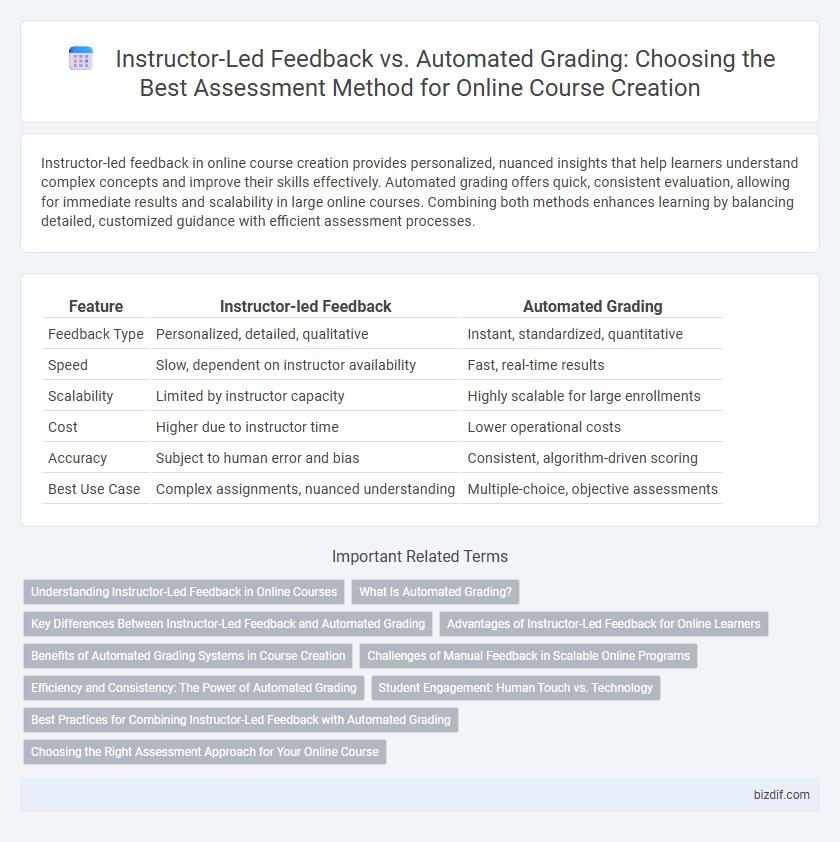Instructor-led feedback in online course creation provides personalized, nuanced insights that help learners understand complex concepts and improve their skills effectively. Automated grading offers quick, consistent evaluation, allowing for immediate results and scalability in large online courses. Combining both methods enhances learning by balancing detailed, customized guidance with efficient assessment processes.
Table of Comparison
| Feature | Instructor-led Feedback | Automated Grading |
|---|---|---|
| Feedback Type | Personalized, detailed, qualitative | Instant, standardized, quantitative |
| Speed | Slow, dependent on instructor availability | Fast, real-time results |
| Scalability | Limited by instructor capacity | Highly scalable for large enrollments |
| Cost | Higher due to instructor time | Lower operational costs |
| Accuracy | Subject to human error and bias | Consistent, algorithm-driven scoring |
| Best Use Case | Complex assignments, nuanced understanding | Multiple-choice, objective assessments |
Understanding Instructor-Led Feedback in Online Courses
Instructor-led feedback in online courses delivers personalized, detailed insights tailored to individual learners, promoting deeper understanding and skill development. Unlike automated grading systems that focus on objective scoring, instructor feedback addresses nuanced performance aspects and encourages critical thinking. This interactive approach fosters engagement and supports adaptive learning paths essential for mastering complex subjects.
What Is Automated Grading?
Automated grading uses algorithms and artificial intelligence to evaluate student performance in online courses, providing instant and consistent feedback on assignments and quizzes. This technology analyzes answers based on predefined criteria, enabling scalable assessment without human intervention. Automated grading enhances efficiency and supports personalized learning by promptly identifying areas where students need improvement.
Key Differences Between Instructor-Led Feedback and Automated Grading
Instructor-led feedback offers personalized, detailed guidance tailored to individual student needs, fostering deeper understanding and skill development through direct human interaction. Automated grading provides rapid, consistent evaluation using algorithms, ideal for large-scale assessments and objective question formats but lacks nuanced insight into complex student responses. The key difference lies in the balance between personalized mentorship in instructor-led feedback and the efficiency and scalability of automated grading systems.
Advantages of Instructor-Led Feedback for Online Learners
Instructor-led feedback offers personalized insights tailored to individual learning styles, enhancing comprehension and retention in online courses. Instructors can address specific learner questions, provide detailed explanations, and adapt feedback dynamically, which automated grading systems often lack. This human interaction fosters engagement, motivation, and a deeper understanding of course material, leading to improved learner outcomes.
Benefits of Automated Grading Systems in Course Creation
Automated grading systems streamline the evaluation process by providing instant, consistent, and unbiased assessment of student work, which significantly reduces instructor workload and accelerates feedback delivery. These systems enhance scalability in online course creation, allowing educators to efficiently manage large student cohorts while maintaining grading accuracy. Integration of AI-driven analytics further supports personalized learning paths by identifying common errors and knowledge gaps automatically.
Challenges of Manual Feedback in Scalable Online Programs
Instructor-led feedback in scalable online programs often faces challenges such as time constraints and inconsistency, limiting personalized support for large student cohorts. Manual grading demands significant instructor effort, which can delay feedback and hinder timely learning interventions. Automated grading systems address scalability but may lack the nuanced understanding required for complex or subjective assignments.
Efficiency and Consistency: The Power of Automated Grading
Automated grading significantly enhances efficiency by instantly evaluating student submissions, reducing turnaround time compared to instructor-led feedback. The system ensures consistent scoring by applying uniform criteria without human bias or fatigue, promoting fairness across all assessments. This reliability allows educators to allocate more time to personalized instruction, while maintaining accurate and timely evaluation metrics.
Student Engagement: Human Touch vs. Technology
Instructor-led feedback fosters deeper student engagement through personalized insights and tailored guidance that adapt to individual learning needs, encouraging active participation and critical thinking. Automated grading offers rapid, consistent assessment that enhances learning efficiency but may lack the nuanced understanding necessary to motivate or address unique student challenges. Balancing the human touch of instructor feedback with the scalability of automated grading optimizes student interaction and supports diverse learning styles.
Best Practices for Combining Instructor-Led Feedback with Automated Grading
Combining instructor-led feedback with automated grading enhances online course effectiveness by leveraging personalized insights alongside efficient assessment. Best practices include using automated grading for objective, repetitive tasks while reserving instructor feedback for complex, nuanced assignments that require critical thinking and creativity. This hybrid approach ensures timely evaluation, maintains student engagement, and supports deeper learning outcomes in digital education environments.
Choosing the Right Assessment Approach for Your Online Course
Instructor-led feedback offers personalized insights and nuanced guidance that can address individual learner needs, boosting engagement and comprehension. Automated grading provides efficiency and scalability through instant scoring and consistent evaluation, ideal for large courses and objective assessments. Balancing these methods depends on course goals, learner preferences, and the complexity of skills being assessed to optimize learning outcomes.
Instructor-led feedback vs Automated grading Infographic

 bizdif.com
bizdif.com